Wideband RCS Reduction Based on Hybrid Checkerboard Metasurface
Abstract
1. Introduction
2. Designs and Methods
3. Results of Simulation and Measurement
4. Conclusions
Author Contributions
Funding
Institutional Review Board Statement
Informed Consent Statement
Data Availability Statement
Conflicts of Interest
References
- Zhang, Z.W.; Cai, Z.H.; Wang, Z.Y.; Peng, Y.L.; Xia, L.; Ma, S.P.; Yin, Z.Z.; Huang, Y. A Review on Metal–Organic Framework-Derived Porous Carbon-Based Novel Microwave Absorption Materials. Nano-Micro Lett. 2021, 13, 1–29. [Google Scholar] [CrossRef]
- Qin, M.; Zhang, L.M.; Wu, H.J. Dielectric Loss Mechanism in Electromagnetic Wave Absorbing Materials. Adv. Sci. 2022, 9, 10. [Google Scholar] [CrossRef] [PubMed]
- Wu, Z.C.; Cheng, H.W.; Jin, C.; Yang, B.T.; Xu, C.Y.; Pei, K.; Zhang, H.B.; Yang, Z.Q.; Che, R.C. Dimensional Design and Core–Shell Engineering of Nanomaterials for Electromagnetic Wave Absorption. Adv. Mater. 2022, 34, 11. [Google Scholar] [CrossRef]
- Zhang, Z.; Cai, Z.; Zhang, Y.; Peng, Y.L.; Wang, Z.Y.; Xia, L. A Review on Metal–Organic Framework-Derived Porous Carbon-Based Novel Microwave Absorption Materials. Carbon Int. J. Spons. Am. Carbon Soc. 2021, 174, 484–499. [Google Scholar] [CrossRef] [PubMed]
- Wu, Y.; Zhao, Y.; Zhou, M.; Tan, S.J.; Peymanfar, R.; Aslibeiki, B. Ultrabroad Microwave Absorption Ability and Infrared Stealth Property of Nano-Micro CuS@rGO Lightweight Aerogels. Nano-Micro Lett. 2022, 14, 171. [Google Scholar] [CrossRef] [PubMed]
- Cheng, H.R.; Pan, Y.M.; Wang, X.; Liu, C.T.; Shen, C.Y. Ni Flower/MXene-Melamine Foam Derived 3D Magnetic/Conductive Networks for Ultra-Efficient Microwave Absorption and Infrared Stealth. Nano-Micro Lett. 2022, 14, 63. [Google Scholar] [CrossRef]
- Smith, D.R.; Pendry, J.B.; Wiltshire, M.C.K. Metamaterials and negative refractive index. Science 2004, 305, 788–792. [Google Scholar] [CrossRef]
- Cui, T.J.; Smith, D.R. Metamaterials; Springer: Spring Street, NY, USA, 2010. [Google Scholar]
- Watts, C.M.; Liu, X. Metamaterial electromagnetic wave absorbers. Adv. Mater. 2012, 24, OP98–OP120. [Google Scholar] [CrossRef]
- Landy, N.I.; Sajuyigbe, S. Perfect metamaterial absorber. Phys. Rev. Lett. 2008, 100, 207402. [Google Scholar] [CrossRef]
- Sabluk, A.; Basharin, A. Metamaterial-based terahertz converter. Mod. Electron. Mater. 2022, 8, 4. [Google Scholar] [CrossRef]
- Paquay, M.; Iriarte, J.C. Thin AMC Structure for Radar Cross-Section Reduction. IEEE Trans. Antennas Propag. 2007, 55, 3630–3638. [Google Scholar] [CrossRef]
- Chen, W.; Balanis, C.A. Checkerboard EBG Surfaces for Wideband Radar Cross Section Reduction. IEEE Trans. Antennas Propag. 2015, 63, 2636–2645. [Google Scholar] [CrossRef]
- Galarregui, J.C.I.; Pereda, A.T. Broadband Radar Cross-Section Reduction Using AMC Technology. IEEE Trans. Antennas Propag. 2013, 61, 6136–6143. [Google Scholar] [CrossRef]
- Edalati, A.; Sarabandi, K. Wideband, Wide Angle, Polarization Independent RCS Reduction Using Nonabsorptive Miniaturized-Element Frequency Selective Surfaces. IEEE Trans. Antennas Propag. 2014, 62, 747–754. [Google Scholar] [CrossRef]
- Zhang, Y.; Mittra, R. AMCs for ultra-thin and broadband RAM design. Electron 2009, 45, 484–485. [Google Scholar] [CrossRef]
- Zheng, Y.; Gao, J. Wideband RCS Reduction of a Microstrip Antenna Using Artificial Magnetic Conductor Structures. IEEE Antennas Wirel. Propag 2015, 14, 1582–1585. [Google Scholar] [CrossRef]
- Mighani, M.; Dadashzadeh, G. Broadband RCS reduction using a novel double layer checkerboard AMC surface. Electron 2016, 52, 1253–1255. [Google Scholar]
- Esmaeli, S.H.; Sedighy, S.H. Wideband radar cross-section reduction by AMC. Electron 2016, 52, 70–71. [Google Scholar] [CrossRef]
- Murugesan, A.; Natarajan, D. Low-cost, wideband checkerboard metasurfaces for monostatic RCS reduction. IEEE Antennas Wirel. Propag. Lett. 2021, 20, 493–497. [Google Scholar] [CrossRef]
- Abdullah, M.; Koziel, S. Surrogate-Assisted Design of Checkerboard Metasurface for Broadband Radar Cross-Section Reduction. IEEE Access 2021, 9, 46744–46754. [Google Scholar] [CrossRef]
- Gao, X.; Han, X.; Cao, W.P.; Li, H.O.; Ma, H.F.; Cui, T.J. Ultrawideband and High-Efficiency Linear Polarization Converter Based on Double V-Shaped Metasurface. IEEE Trans. Antennas Propag. 2015, 63, 3522–3530. [Google Scholar] [CrossRef]
- Chen, H.; Wang, J.; Ma, H.; Qu, S.; Xu, Z.; Zhang, A.; Yan, M.; Li, Y. Ultra-wideband polarization conversion metasurfaces based on multiple plasmon resonances. Appl. Phys 2014, 115, 154504. [Google Scholar] [CrossRef]
- Deng, G.Y.; Zhang, Y.H. Ultrabroadband RCS Reduction Design by Exploiting Characteristic Complementary Polarization Conversion Metasurfaces. IEEE Trans. Antennas Propag. 2022, 70, 2904–2914. [Google Scholar] [CrossRef]
- Lin, B.Q.; Huang, W.Z. Ultra-Wideband and Polarization-Independent RCS Reduction Based on Polarization Conversion Metasurface. Radio Sci. 2022, 57, 2. [Google Scholar] [CrossRef]
- Yang, J.; Liao, Z. Phase modulation of metasurfaces for polarization conversion and RCS reduction. Opt. Mater. 2021, 119, 111374. [Google Scholar] [CrossRef]
- Chen, Y.; Xu, C. Stealth design of polarization conversion metasurface antenna array. Microw. Opt. Technol. Lett. 2021, 63, 11. [Google Scholar] [CrossRef]
- Zheng, Q.; Guo, C.; Ding, J. A Broadband Low-RCS Metasurface for CP Patch Antennas. IEEE Trans. Antennas Propag. 2021, 69, 3529–3534. [Google Scholar] [CrossRef]
- Fu, C.; Han, L.; Liu, C. Dual-Band Polarization Conversion Metasurface for RCS Reduction. IEEE Trans. Antennas Propag. 2021, 69, 3044–3049. [Google Scholar] [CrossRef]
- Chatterjee, J.; Mohan, A. Ultrawideband RCS Reduction of Planar and Conformal Surfaces Using Ultrathin Polarization Conversion Metasurface. IEEE Access 2022, 10, 36563–36575. [Google Scholar] [CrossRef]
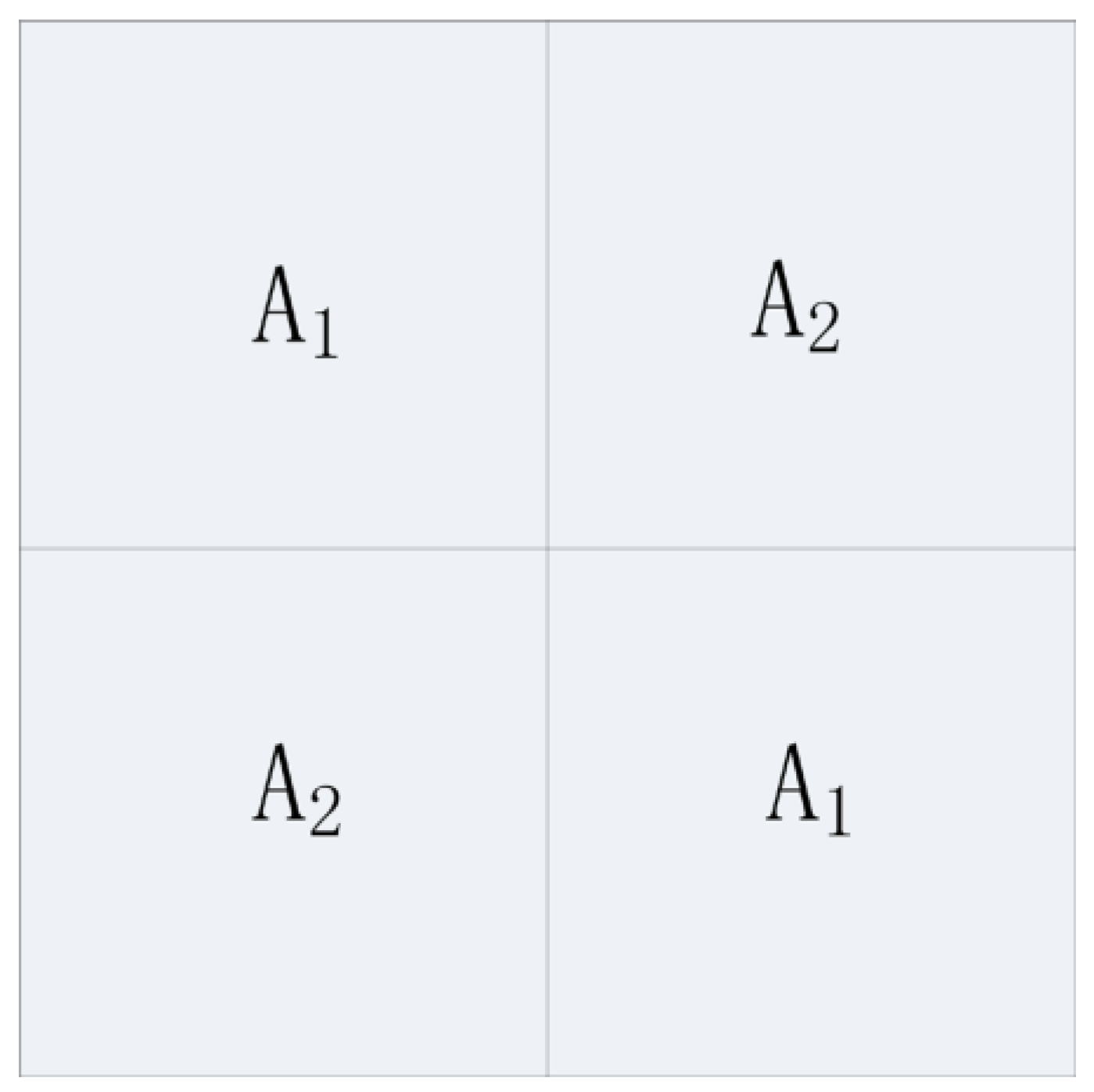


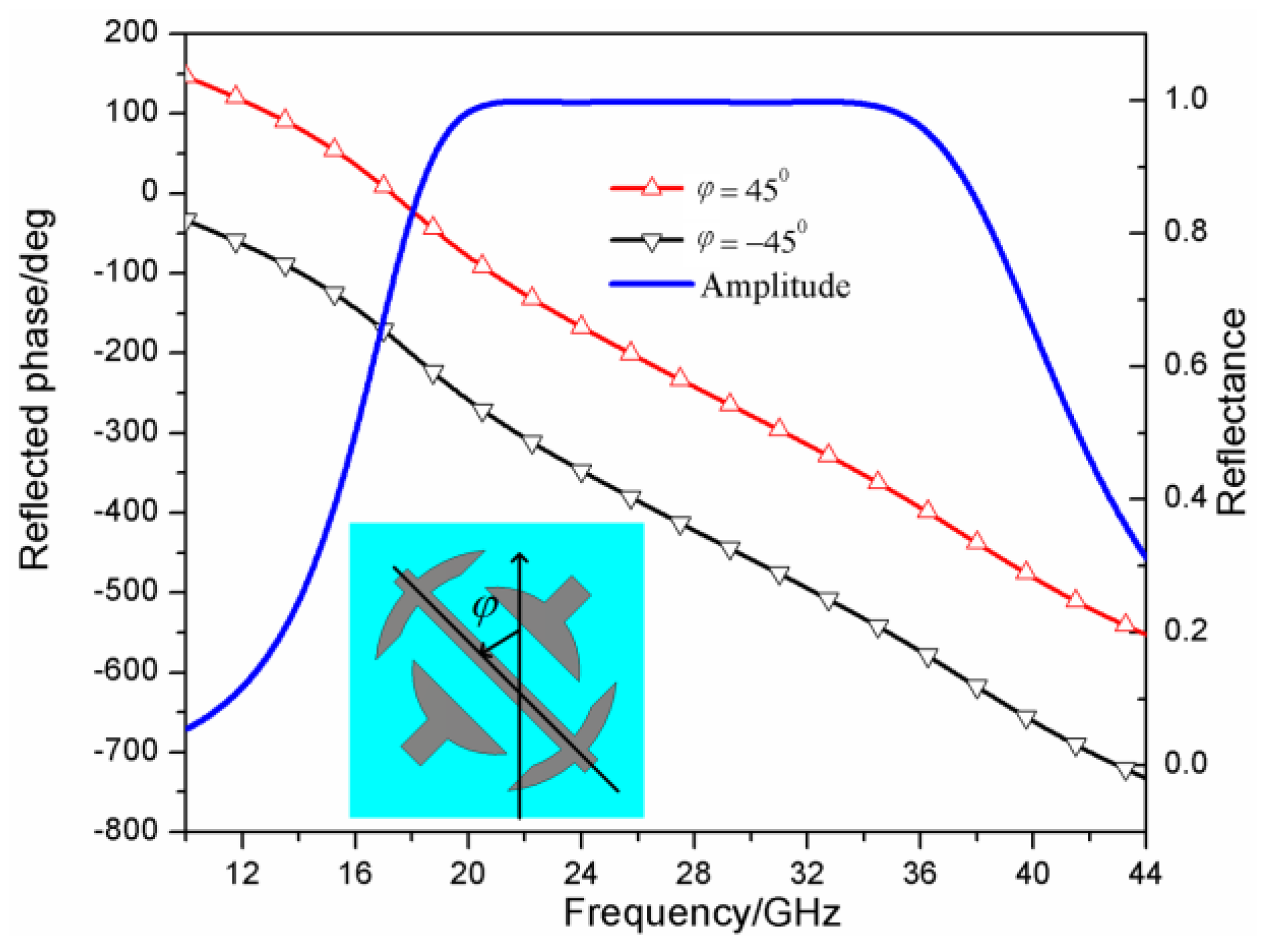
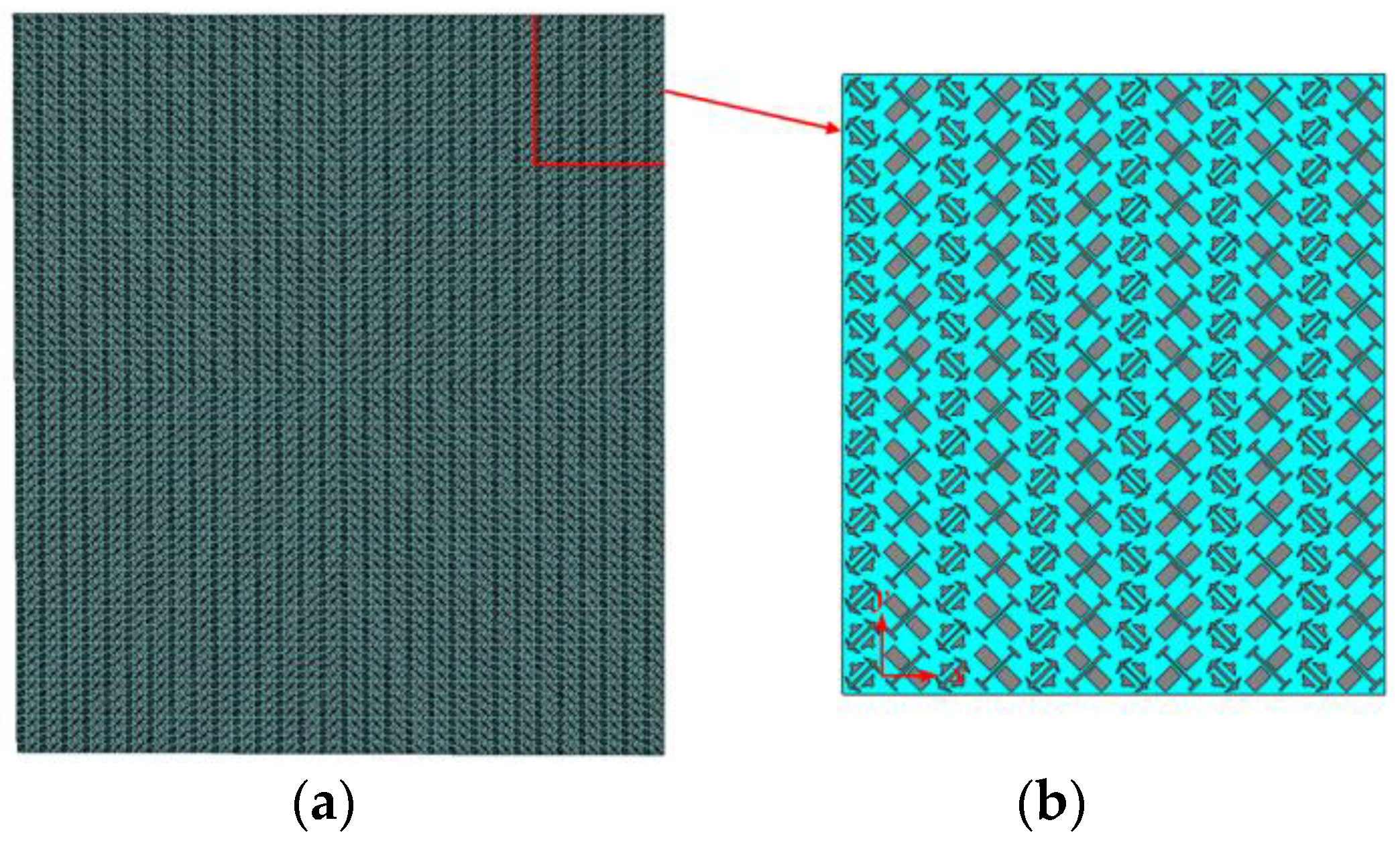
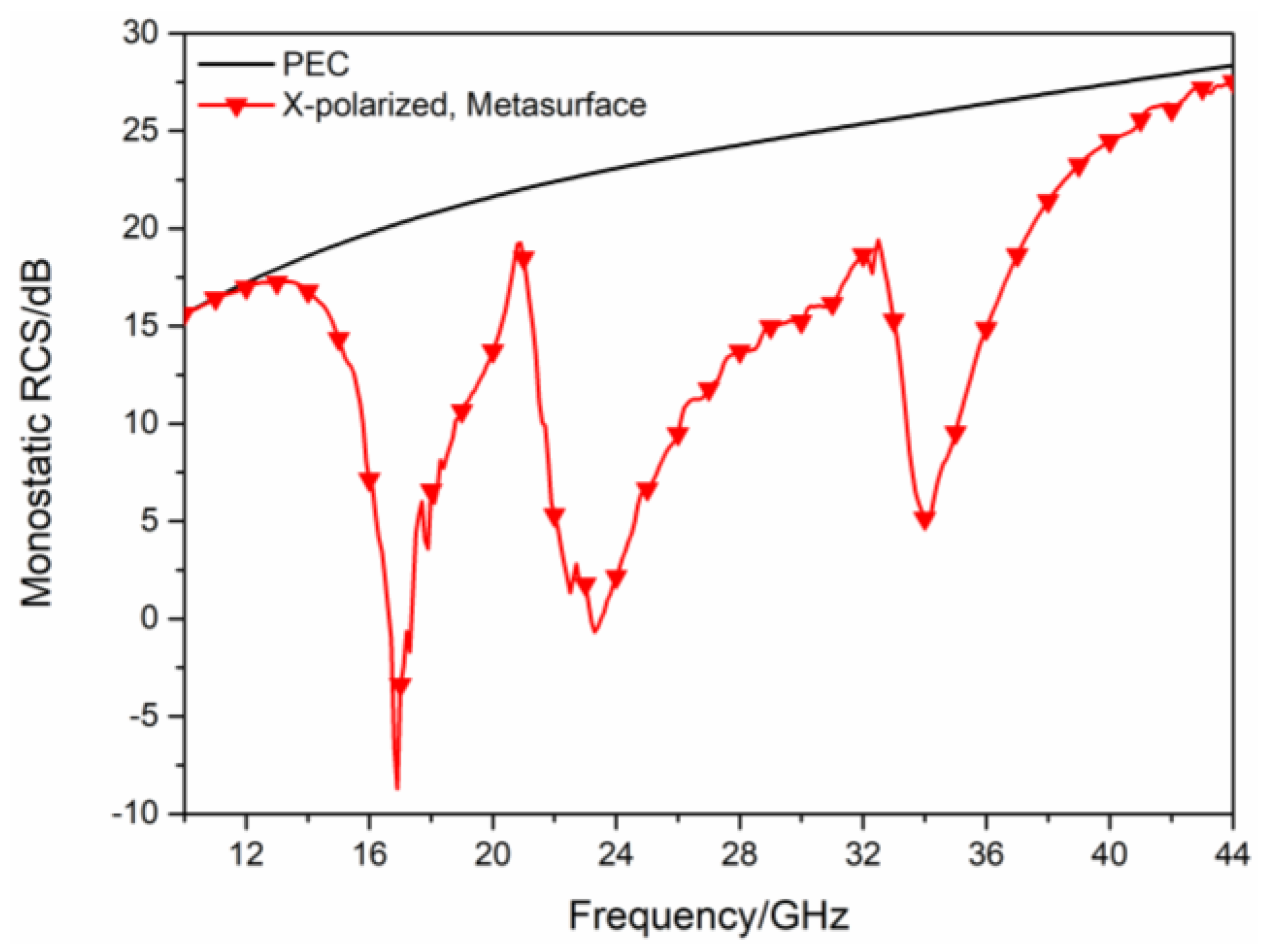
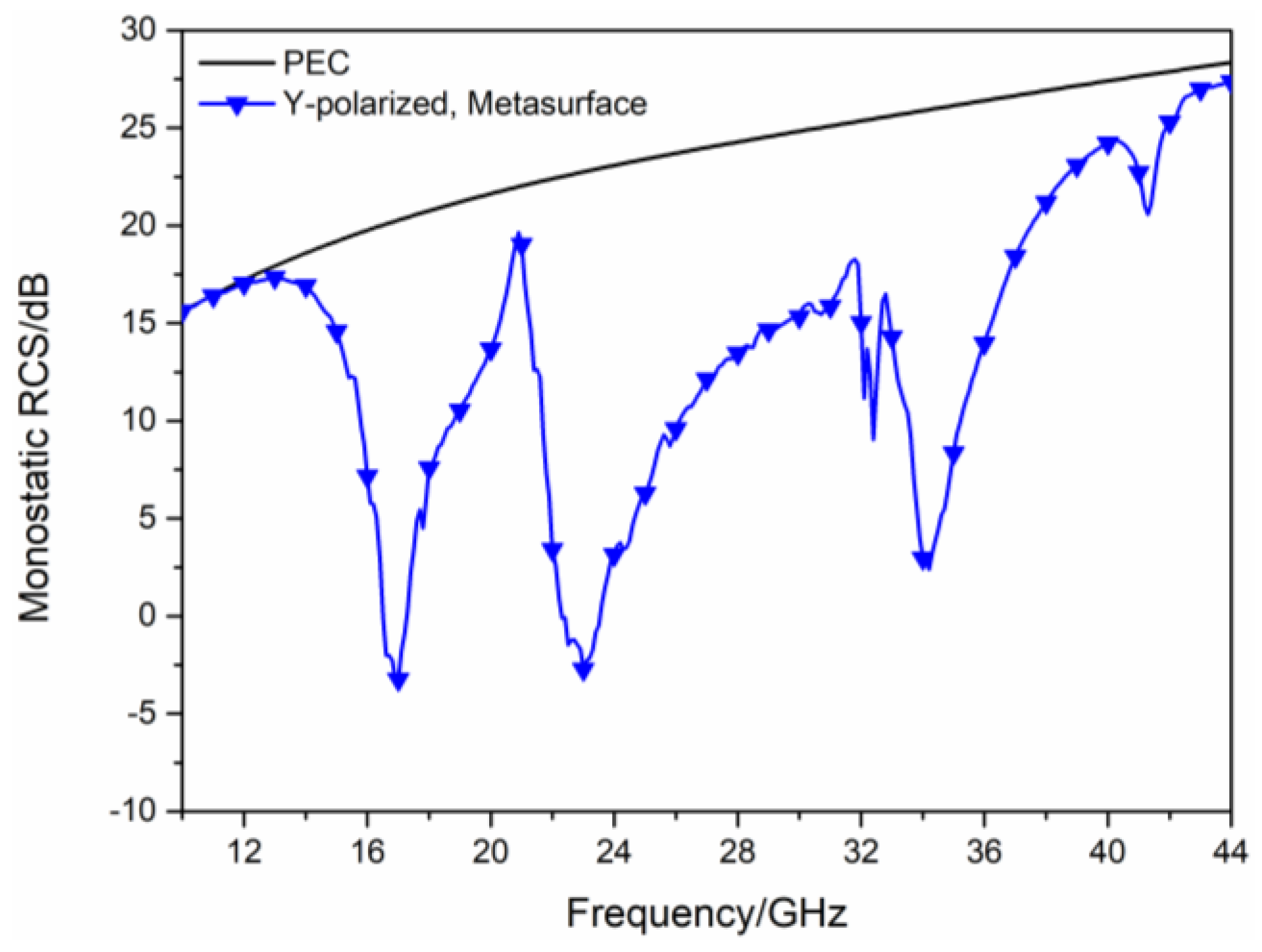

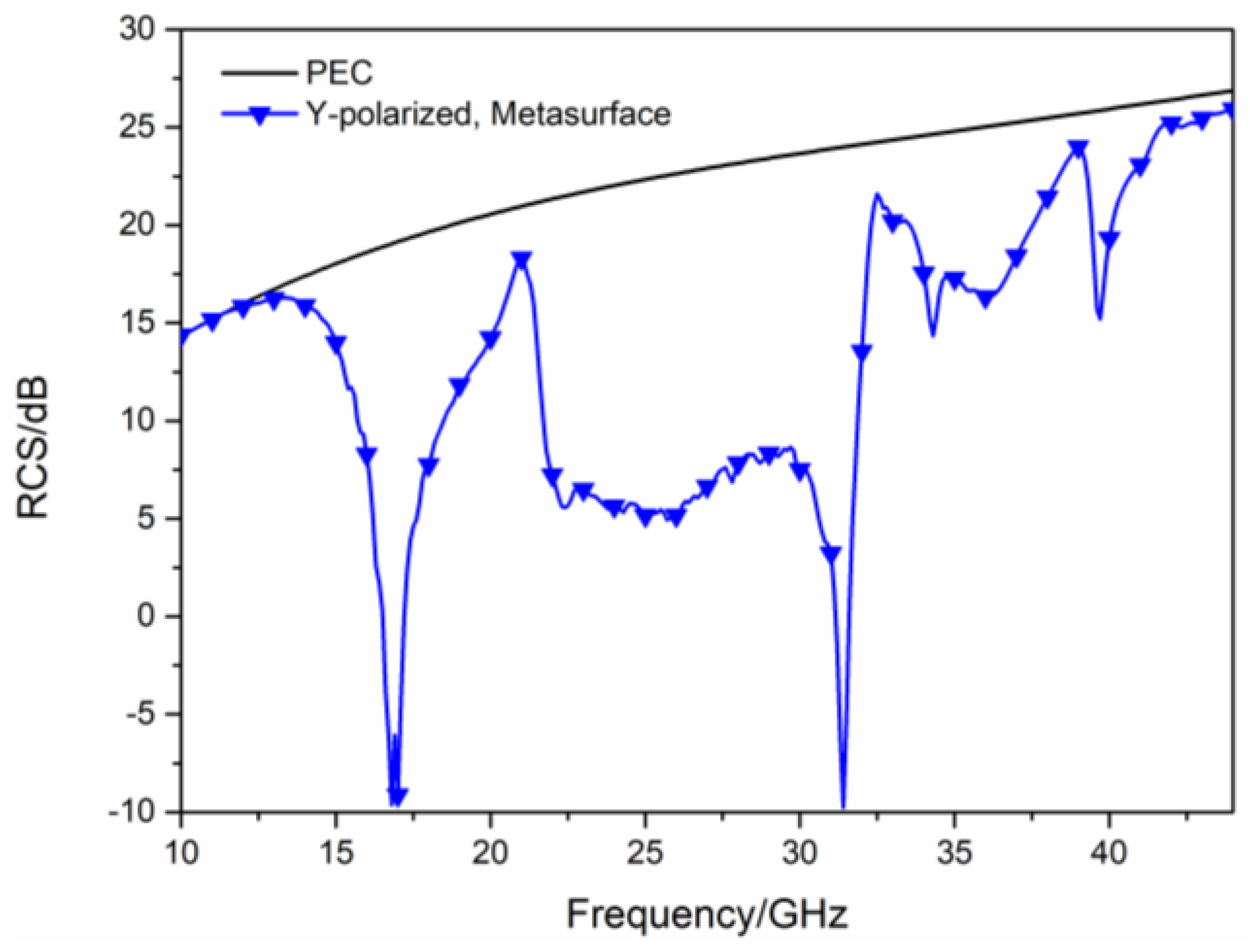
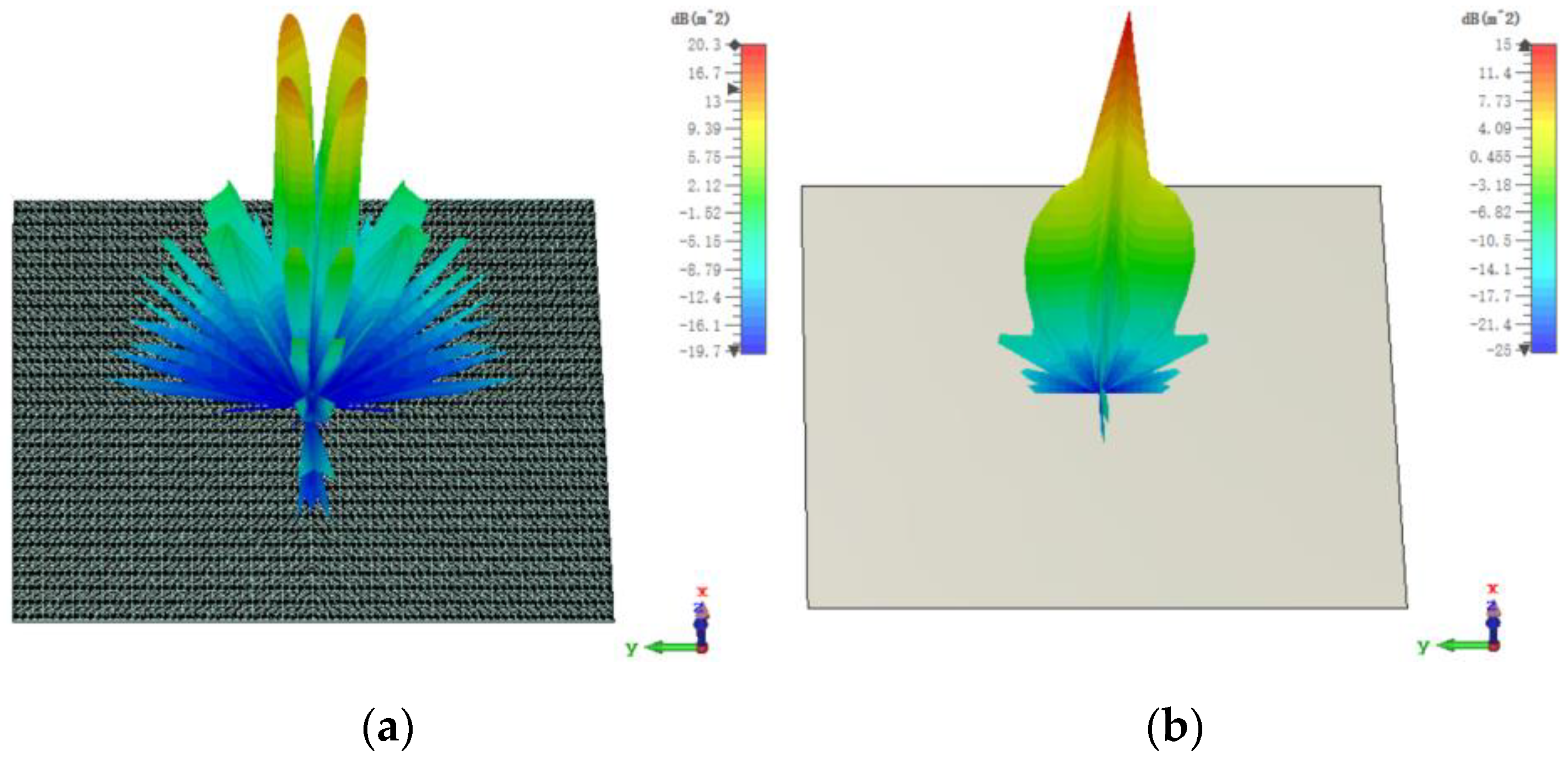
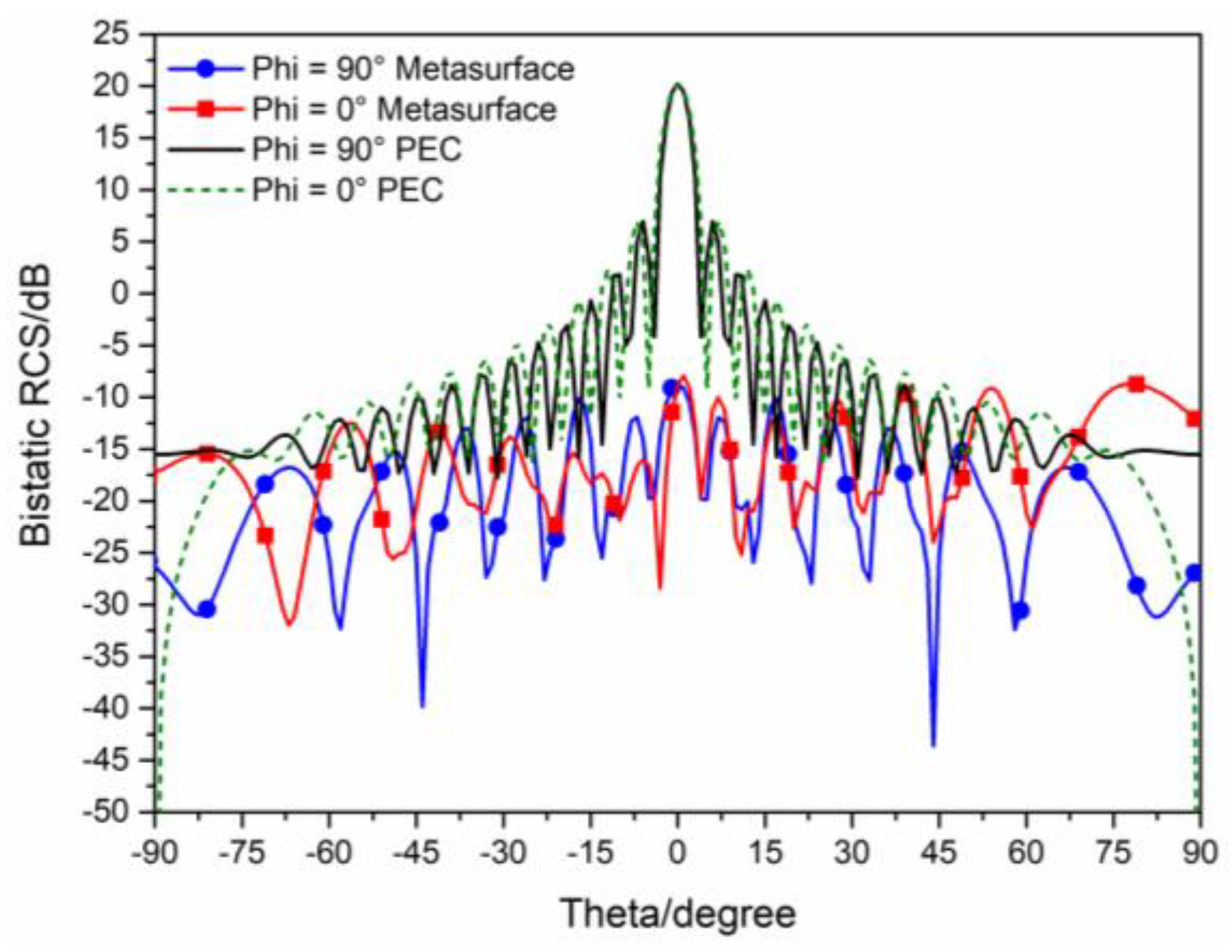
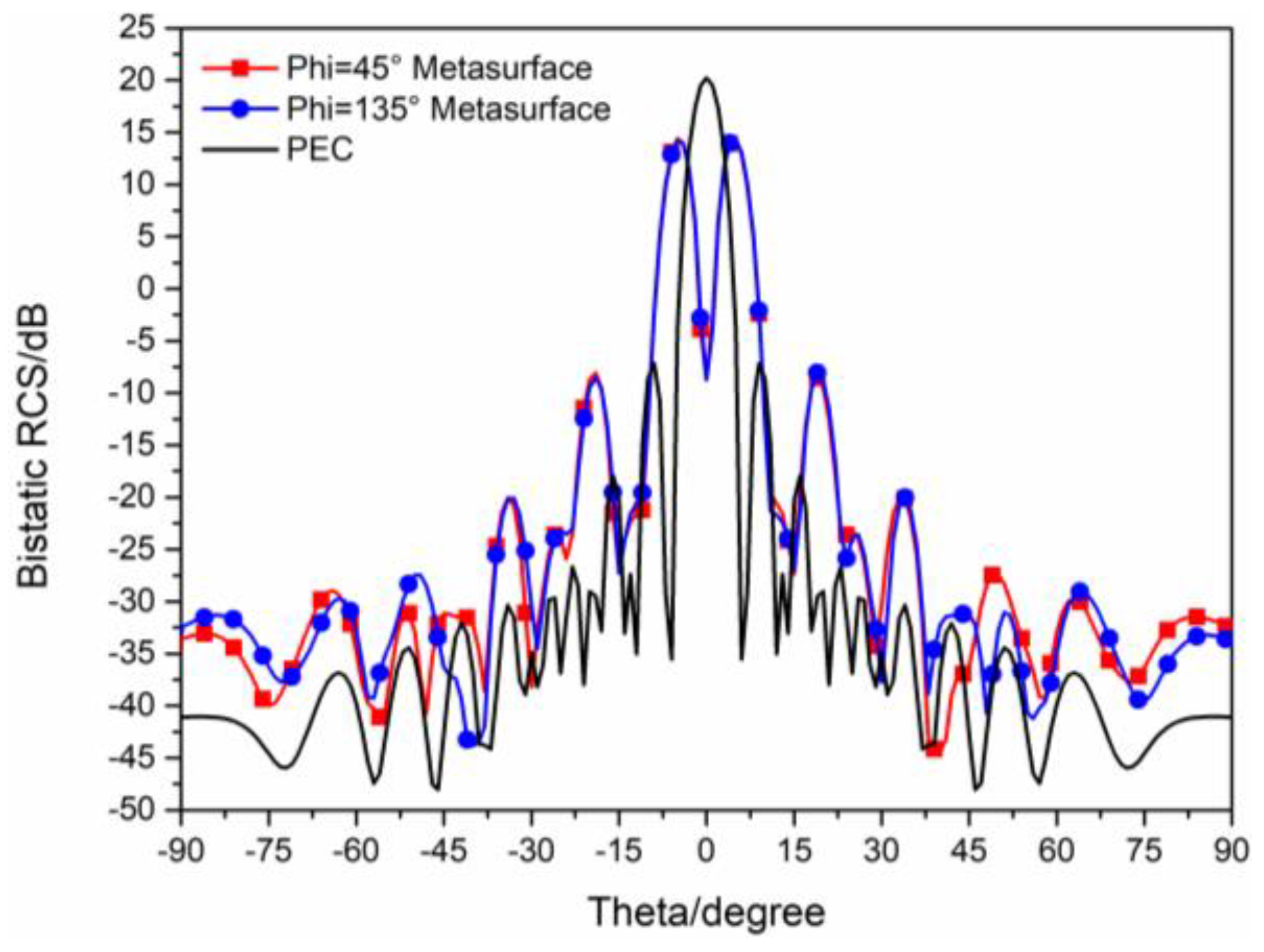
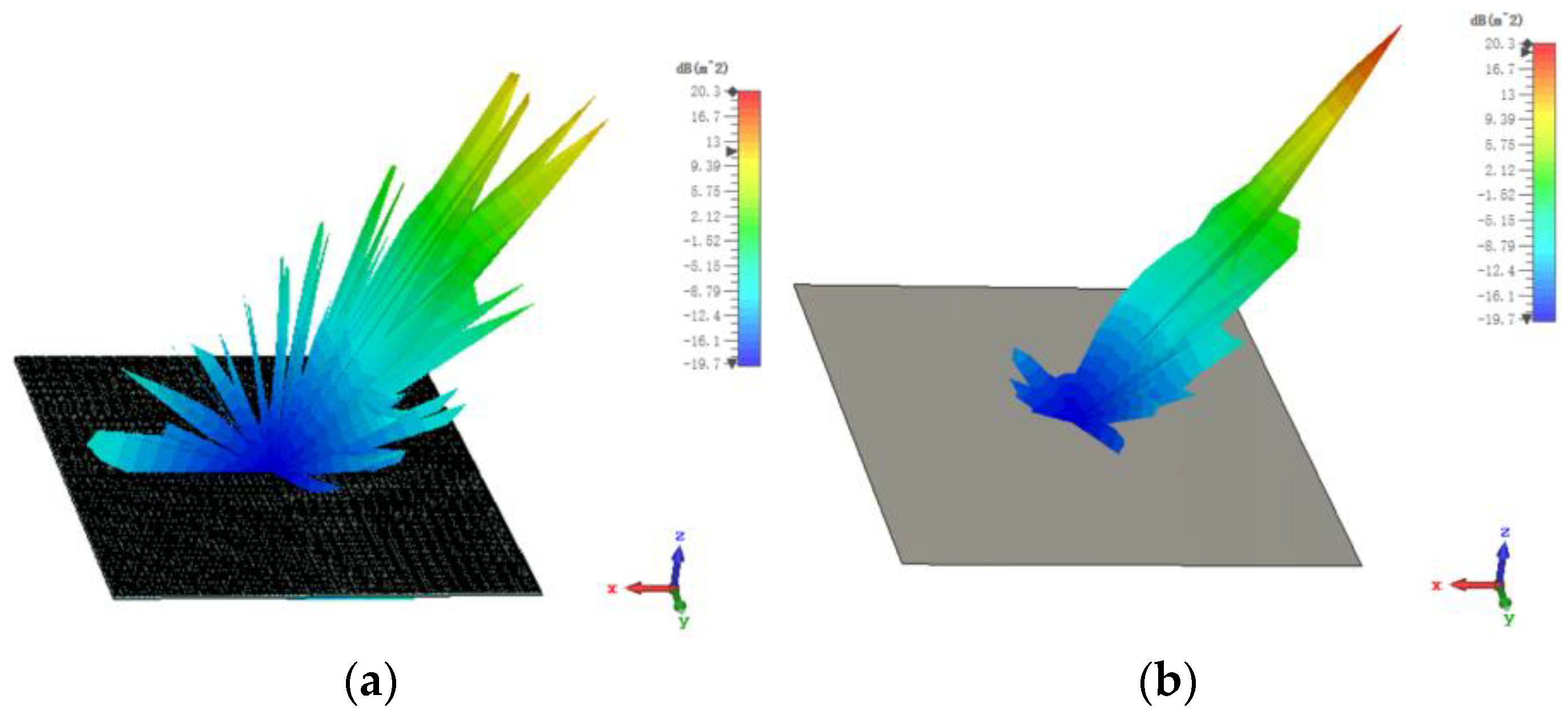


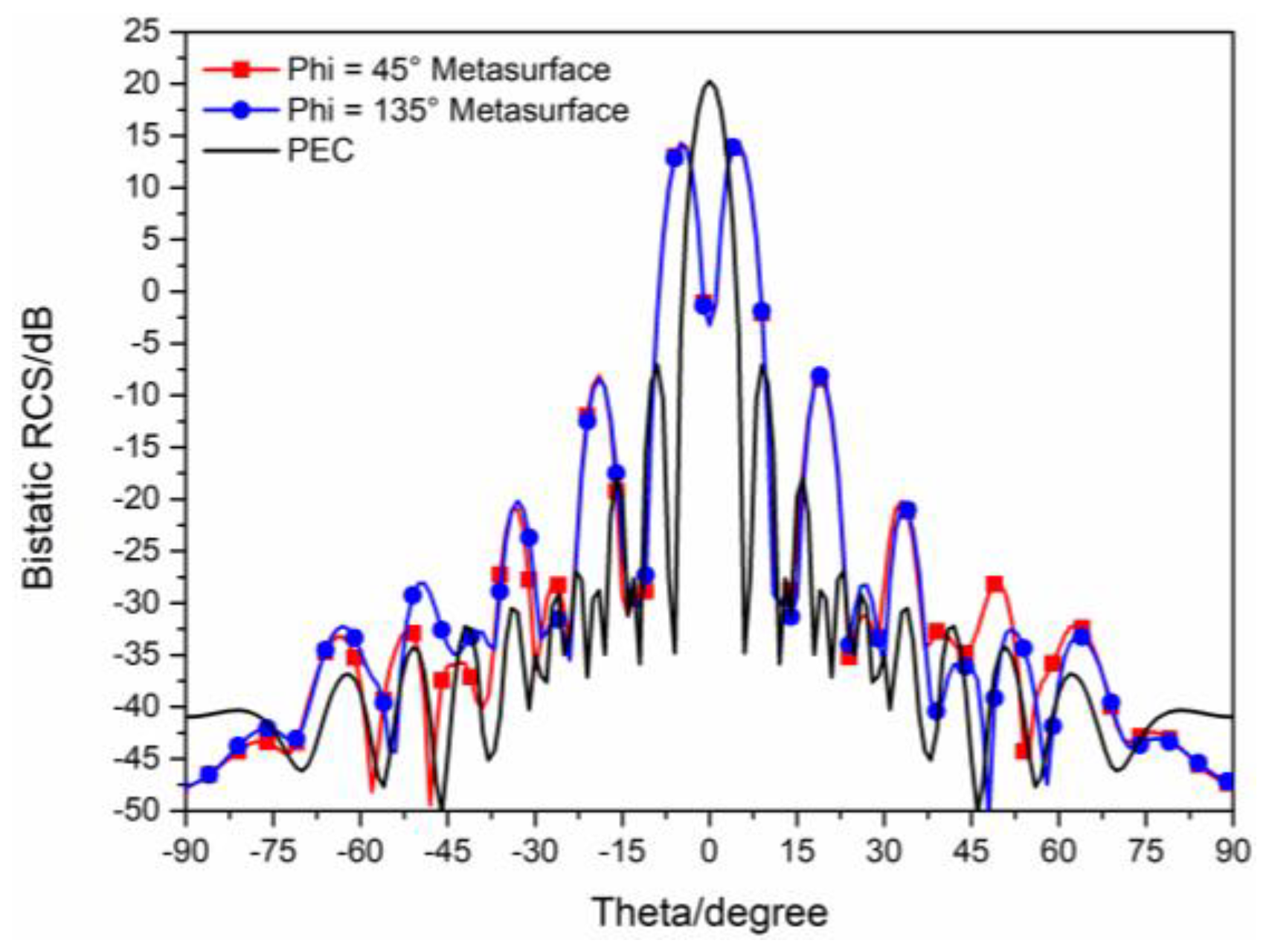
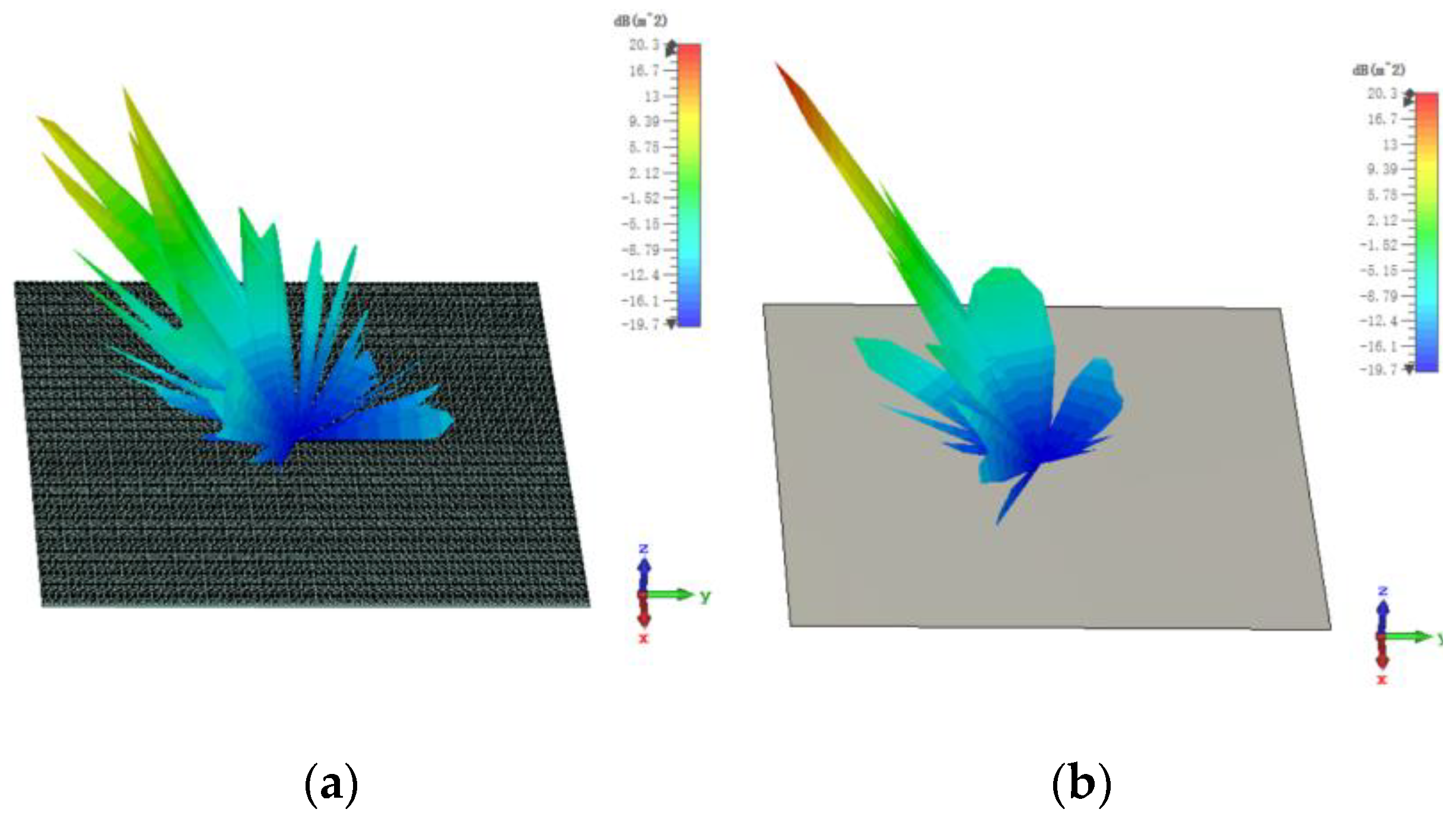
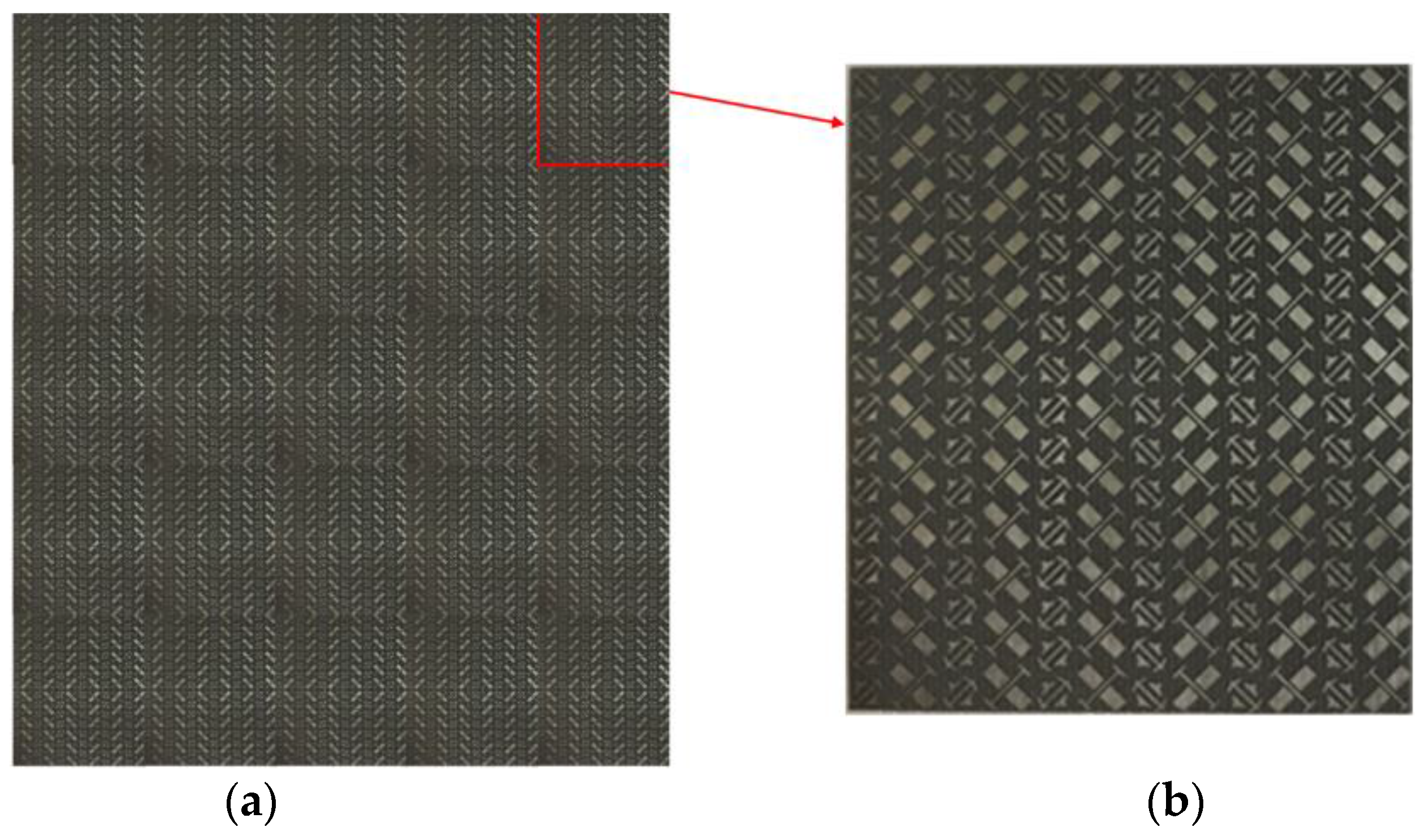
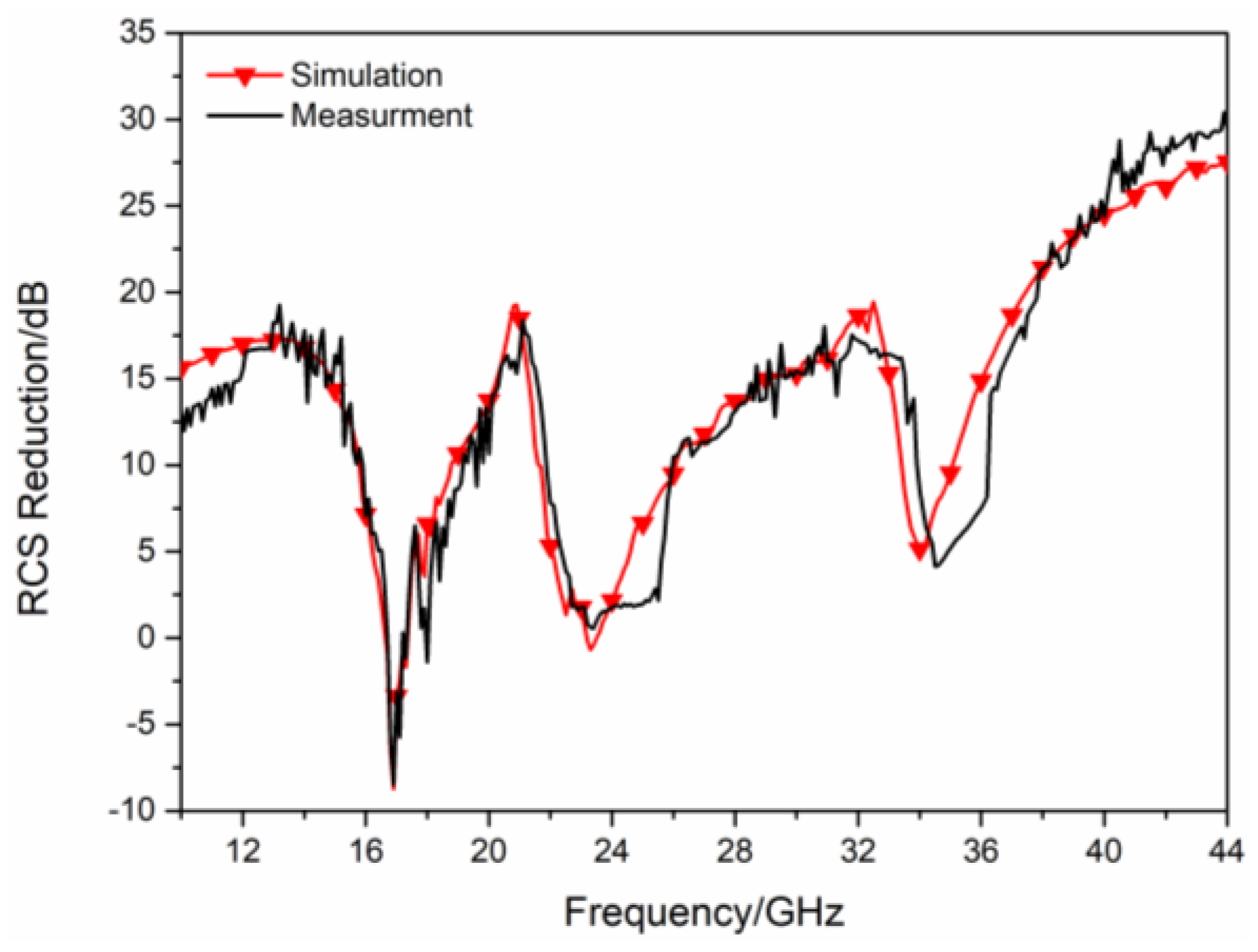
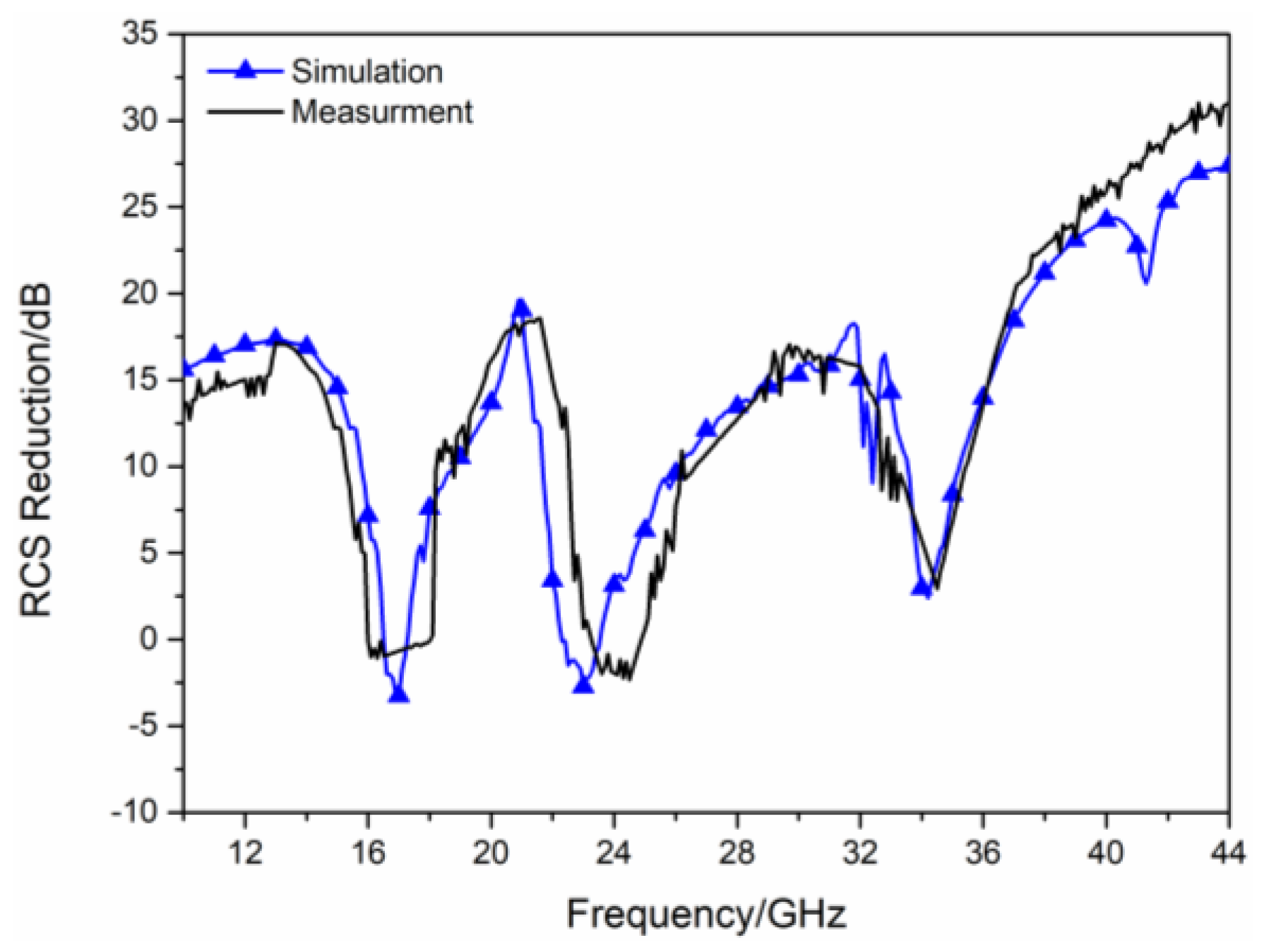
Disclaimer/Publisher’s Note: The statements, opinions and data contained in all publications are solely those of the individual author(s) and contributor(s) and not of MDPI and/or the editor(s). MDPI and/or the editor(s) disclaim responsibility for any injury to people or property resulting from any ideas, methods, instructions or products referred to in the content. |
© 2023 by the authors. Licensee MDPI, Basel, Switzerland. This article is an open access article distributed under the terms and conditions of the Creative Commons Attribution (CC BY) license (https://creativecommons.org/licenses/by/4.0/).
Share and Cite
Zhao, Z.; Li, X.; Dong, G. Wideband RCS Reduction Based on Hybrid Checkerboard Metasurface. Sensors 2023, 23, 4054. https://doi.org/10.3390/s23084054
Zhao Z, Li X, Dong G. Wideband RCS Reduction Based on Hybrid Checkerboard Metasurface. Sensors. 2023; 23(8):4054. https://doi.org/10.3390/s23084054
Chicago/Turabian StyleZhao, Zhiming, Xiaoping Li, and Guoxiang Dong. 2023. "Wideband RCS Reduction Based on Hybrid Checkerboard Metasurface" Sensors 23, no. 8: 4054. https://doi.org/10.3390/s23084054
APA StyleZhao, Z., Li, X., & Dong, G. (2023). Wideband RCS Reduction Based on Hybrid Checkerboard Metasurface. Sensors, 23(8), 4054. https://doi.org/10.3390/s23084054





